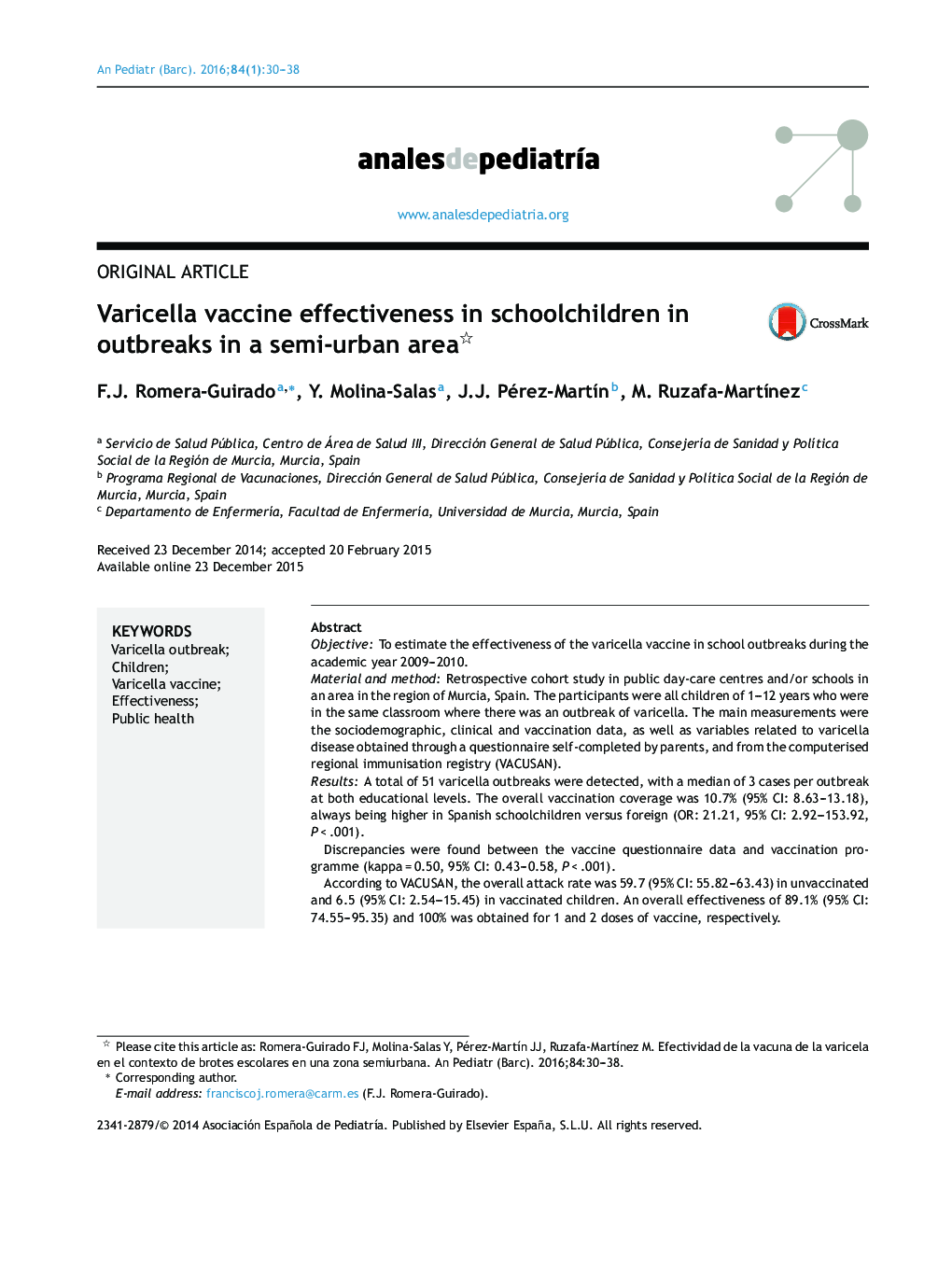| کد مقاله | کد نشریه | سال انتشار | مقاله انگلیسی | نسخه تمام متن |
|---|---|---|---|---|
| 4145093 | 1272586 | 2016 | 9 صفحه PDF | دانلود رایگان |
ObjectiveTo estimate the effectiveness of the varicella vaccine in school outbreaks during the academic year 2009–2010.Material and methodRetrospective cohort study in public day-care centres and/or schools in an area in the region of Murcia, Spain. The participants were all children of 1–12 years who were in the same classroom where there was an outbreak of varicella. The main measurements were the sociodemographic, clinical and vaccination data, as well as variables related to varicella disease obtained through a questionnaire self-completed by parents, and from the computerised regional immunisation registry (VACUSAN).ResultsA total of 51 varicella outbreaks were detected, with a median of 3 cases per outbreak at both educational levels. The overall vaccination coverage was 10.7% (95% CI: 8.63–13.18), always being higher in Spanish schoolchildren versus foreign (OR: 21.21, 95% CI: 2.92–153.92, P < .001).Discrepancies were found between the vaccine questionnaire data and vaccination programme (kappa = 0.50, 95% CI: 0.43–0.58, P < .001).According to VACUSAN, the overall attack rate was 59.7 (95% CI: 55.82–63.43) in unvaccinated and 6.5 (95% CI: 2.54–15.45) in vaccinated children. An overall effectiveness of 89.1% (95% CI: 74.55–95.35) and 100% was obtained for 1 and 2 doses of vaccine, respectively.ConclusionsThere is a high effectiveness of varicella vaccine, emphasising that the administration of two doses of vaccine produces an adequate and optimal protection against varicella disease. A discrepancy was found between the information provided by parents and official records. Finally, there was a lower vaccination coverage in the immigrant community.
ResumenObjetivoCalcular la efectividad de la vacuna de la varicela en brotes escolares durante el curso académico 2009-2010.Material y métodoEstudio de cohortes retrospectivo realizado en guarderías y/o colegios de educación infantil o primaria públicos de un municipio de la Región de Murcia, España. Los participantes fueron el alumnado de 1 a 12 años que acudía a la misma aula donde se produjo un brote de varicela. Las mediciones principales fueron: datos sociodemográficos, antecedentes clínicos y de vacunación y variables relacionadas con la enfermedad varicelosa obtenidos a través de un cuestionario autocumplimentado por padres y/o tutores y del registro regional informatizado de vacunas (VACUSAN).ResultadosSe detectaron 51 brotes de varicela, con una mediana de 3 casos por brote en ambos niveles educativos. La cobertura vacunal global fue del 10,7% (IC del 95%, 8,63-13,18), siendo siempre muy superior en el alumnado de nacionalidad española frente al de nacionalidad extranjera (OR = 21,21; IC del 95%, 2,92-153,92; p < 0,001).Encontramos discrepancias entre los datos vacunales del cuestionario y el programa informatizado de vacunaciones (kappa = 0,50 (IC del 95%, 0,43-0,58), p < 0,001).La tasa de ataque global según VACUSAN fue de 59,7 (IC del 95%, 55,82-63,43) en no vacunados y de 6,5 (IC del 95%, 2,54-15,45) en vacunados. Obtuvimos una efectividad global del 89,1% (IC del 95%, 74,55-95,35) y 100% para una y 2 dosis de vacuna, respectivamente.ConclusionesElevada efectividad de la vacuna de la varicela y muy especialmente en un esquema de vacunación de 2 dosis. Se han detectado discrepancias entre la información aportada por los padres y los registros informatizados regionales, así como una diferencia en la cobertura de vacunación en función de la nacionalidad.
Journal: Anales de Pediatría (English Edition) - Volume 84, Issue 1, January 2016, Pages 30–38
